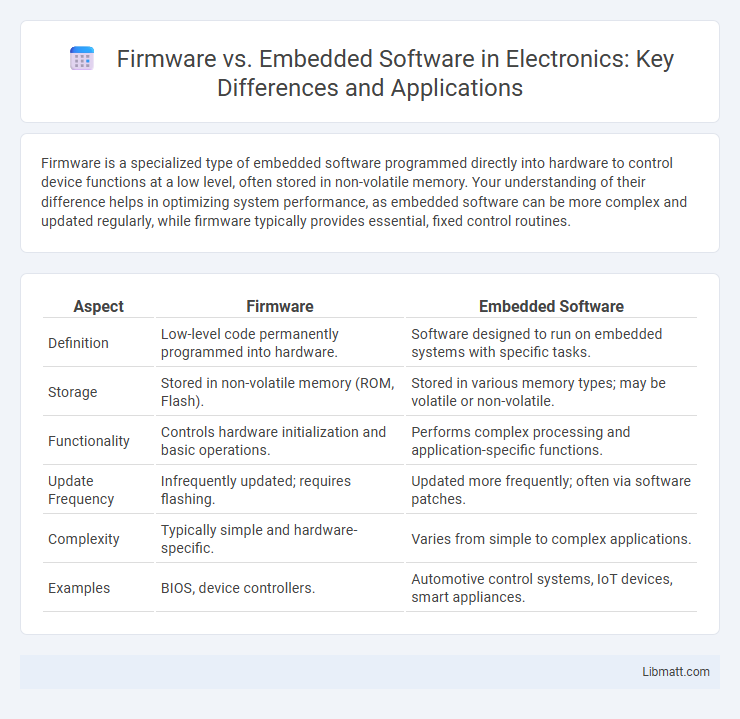Firmware is a specialized type of embedded software programmed directly into hardware to control device functions at a low level, often stored in non-volatile memory. Your understanding of their difference helps in optimizing system performance, as embedded software can be more complex and updated regularly, while firmware typically provides essential, fixed control routines.
Table of Comparison
| Aspect | Firmware | Embedded Software |
|---|---|---|
| Definition | Low-level code permanently programmed into hardware. | Software designed to run on embedded systems with specific tasks. |
| Storage | Stored in non-volatile memory (ROM, Flash). | Stored in various memory types; may be volatile or non-volatile. |
| Functionality | Controls hardware initialization and basic operations. | Performs complex processing and application-specific functions. |
| Update Frequency | Infrequently updated; requires flashing. | Updated more frequently; often via software patches. |
| Complexity | Typically simple and hardware-specific. | Varies from simple to complex applications. |
| Examples | BIOS, device controllers. | Automotive control systems, IoT devices, smart appliances. |
Introduction to Firmware and Embedded Software
Firmware is a specialized type of software programmed directly into hardware devices, providing low-level control and enabling essential functions within embedded systems. Embedded software operates at a higher level, managing hardware resources and executing application-specific tasks to enhance device functionality. Both firmware and embedded software are critical components in the design and operation of embedded systems, with firmware serving as the foundational layer and embedded software building on top to deliver complex capabilities.
Defining Firmware: Key Features and Roles
Firmware is a specialized type of software embedded directly into hardware devices, providing low-level control and enabling the device's fundamental operations. Key features include non-volatile storage, tight integration with hardware components, and the ability to function independently without an operating system. Its primary role involves managing device initialization, hardware communication, and ensuring stable, reliable performance in embedded systems.
What is Embedded Software? Scope and Applications
Embedded software is specialized programming designed to operate hardware devices and systems within larger mechanical or electronic frameworks, enabling specific functionalities and real-time control. Its scope encompasses microcontrollers, IoT devices, automotive systems, industrial machines, and consumer electronics, where it manages hardware performance and user interactions. Your ability to optimize device performance and reliability depends on understanding embedded software's critical role in seamlessly integrating software with physical components.
Core Differences Between Firmware and Embedded Software
Firmware is a specialized type of software permanently programmed into read-only memory (ROM) or flash memory, providing low-level control and startup operations for hardware devices. Embedded software operates on microcontrollers or microprocessors within embedded systems, offering more flexibility by controlling hardware functions and performing application-specific tasks with the ability to be updated or modified. The core difference lies in permanence and scope: firmware is typically immutable and hardware-focused, whereas embedded software is adaptable and manages broader system functions.
Hardware Dependency: Firmware vs Embedded Software
Firmware is closely tied to specific hardware components, providing low-level control and direct interaction with device circuits, making it highly hardware-dependent. Embedded software operates on microcontrollers or processors within embedded systems but can offer more flexibility across similar hardware platforms through abstraction layers. This distinction highlights firmware's critical role in hardware initialization and embedded software's broader functionality in application-level tasks.
Update and Modification Processes
Firmware updates often require specialized tools or manufacturer support, making modifications less frequent and more controlled compared to embedded software. Embedded software can be updated more flexibly through standard interfaces like USB or wireless protocols, enabling quicker patches and feature enhancements. Your ability to modify embedded software easily supports continuous improvement and customization, whereas firmware updates prioritize stability and hardware compatibility.
Typical Use Cases in Industry
Firmware is essential for controlling hardware devices like routers, printers, and medical instruments, providing low-level control directly interfacing with the hardware components. Embedded software powers complex systems such as automotive control units, industrial robots, and consumer electronics, managing real-time operations and system functionalities beyond basic hardware initialization. Understanding the distinctions in your industry helps optimize device performance and reliability, ensuring firmware handles hardware-specific tasks while embedded software manages more advanced application processes.
Security Concerns and Approaches
Firmware and embedded software both require robust security measures due to their critical roles in device operation and vulnerability to attacks. Security concerns for firmware include ensuring code integrity and preventing unauthorized updates through secure boot mechanisms and cryptographic signatures. Embedded software security approaches emphasize real-time intrusion detection, sandboxing, and regular patching to mitigate risks from malware and remote exploitation.
Development Tools and Environments
Firmware development primarily utilizes low-level programming languages like C or assembly, often within integrated development environments (IDEs) tailored for specific microcontrollers, such as Keil or MPLAB. Embedded software development involves more extensive use of real-time operating systems (RTOS) and higher-level tools like Eclipse or IAR Embedded Workbench, supporting complex application layers and middleware integration. Your choice between firmware and embedded software tools depends on the hardware constraints and the system's complexity.
Choosing the Right Solution: Firmware or Embedded Software
Choosing between firmware and embedded software depends on your device's complexity and update requirements. Firmware offers low-level control and stability for hardware, ideal for simple devices, while embedded software provides greater flexibility and functionality for complex systems. Your choice impacts performance, maintainability, and upgrade potential in embedded development.
Firmware vs Embedded software Infographic

 libmatt.com
libmatt.com